HOME SCIENCE
PAPER – III
Note : This paper contains seventy five (75) objective type questions of two (2) marks each. All questions are compulsory.
1. Folic acid deficiency results in
(1) Hypochromic microcytic anaemia
(2) Megaloblastic anaemia
(3) Pernicious anaemia
(4) Normochromic microcytic anaemia
2. The following method is used for the estimation of amino acids :
(1) Kjeldhal’s test
(2) Fehling’s test
(3) Ninhydrin test
(4) Benedict’s test
3. As per ATP classification the desirable level of cholesterol in the serum is
(1) < 240 mg/dl
(2) < 200 mg/dl
(3) < 220 mg/dl
(4) < 260 mg/dl
4. A structural method of learning better processes or techniques from other similar establishments and implementing them in your own system is called
(1) Forecasting
(2) Scheduling
(3) Directing
(4) Benchmarking
5. Which of the following is obtained from leaf ?
(1) Palm
(2) Hemp
(3) Milk-weed
(4) Kapok
6. Thickener that does not require washing out after printing is
(1) Emulsion binder
(2) Gelatin
(3) Starch
(4) Gum
7. Managerial and psychosocial sub-systems are parts of which environment ?
(1) Household environment
(2) Near environment
(3) Large environment
(4) External environment
8. Indicate the institution related to energy conservation measures :
(1) ICMR
(2) NBO
(3) HUDCO
(4) BEE
9. Inadequate oxygen supply during labour and delivery is called _____ in babies.
(1) Anorexia
(2) Anoxia
(3) Amnesia
(4) Arrhythmia
10. An organised pattern of physical growth that proceeds from the centre of the body outward :
(1) Proximodistal
(2) Cephalocaudal
(3) Preformationism
(4) Epigenesis
11. The total number of Sustainable Development Goals (SDGs), to be achieved by the year 2030 are
(1) 10
(2) 12
(3) 15
(4) 17
12. The full form of SITE in context of development communication and extension education is
(1) Satellite Information and Training Experiment
(2) Satellite Information and Training Education
(3) Satellite Instructional Television Experiment
(4) Satellite Instructional Tele-communication Education
13. Following are Class I preservatives used in foods :
I. Salt II. Dextrose
III. Acetic acid
IV. Sulphur dioxide
V. Spices
VI. Benzoic acid
Codes :
(1) I, II, III, IV
(2) II, III, V, VI
(3) I, II, III, V
(4) I, III, IV, VI
14. Following are the services provided by ICDS to the beneficiaries :
I. Supplementary nutrition
II. Antenatal checkup
III. Non-formal education
IV. Growth monitoring
V. Supply of iodized salt
Codes :
(1) I, III, IV
(2) I, II, III
(3) I, II, V
(4) II, III, IV
15. Assessment of obesity can be done by following :
I. BMI
II. Weight for height
III. WHR
IV. BMR
V. Blood Pressure VI. Skin Fold measurement
Codes :
(1) I, II, IV, VI
(2) I, II, IV, V
(3) II, III, IV, VI
(4) I, II, III, VI
16. Following foods have a high cholesterol content :
I. Butter
II. Cottage cheese
III. Egg Yolk
IV. Liver
V. Milk
Codes :
(1) II, III, IV
(2) I, III, IV
(3) III, IV, V
(4) I, II, V
17. Following are the symptoms of Cirrhosis of liver :
I. Jaundice
II. Dehydration
III. Ascites
IV. Peripheral neuropathy
V. Oesophageal varices
Codes :
(1) I, II, IV
(2) I, IV, V
(3) I, II, V
(4) I, III, V
18. Which of the following are characteristics of a commissary food service system ?
I. Centralized purchasing is done for all service units.
II. Food is transported to satellite serving units.
III. All convenience and prepared foods are purchased, assembled and served.
IV. Purchase is for own unit.
V. Central production kitchen is in building separate from service units.
Codes :
(1) II, III, V
(2) I, II, V
(3) III, IV, V
(4) II, IV, V
19. Which of the following stitch classes are examples of chain stitch ?
I. 100
II. 200
III. 300
IV. 400
Codes :
(1) I and II
(2) II and III
(3) III and IV
(4) I and IV
20. Which of the following are varieties of Kashida Stitches ?
I. Zalakdozi
II. Rafuqari
III. Bagh
IV. Vata-Chikan
Codes :
(1) I, II, IV
(2) II, III, IV
(3) III, IV, I
(4) I, II, III
21. Which of the following finishes enhance comfort and aftercare properties ?
I. Bacteriostatic
II. Durable press
III. Antistatic
IV. Flame resistance
Codes :
(1) I and II
(2) II and III
(3) III and IV
(4) I and IV
22. Which among the following satisfy ergonomic benefits ?
I. Safer jobs
II. Improved efficiency and productivity
III. Fewer injuries
IV. Increase in absenteeism
V. Effective financial management
Codes :
(1) I, II and IV
(2) III, IV and V
(3) II, III and IV
(4) I, II and III
23. Identify the major contributors to human energy (work) studies :
I. Munsell
II. Taylor
III. Khushoo
IV. Gilbreth
V. Mundell
Codes :
(1) I, II and IV
(2) II, IV and V
(3) II, III and V
(4) I, IV and V
24. Laws of mechanics that apply to body mechanics are :
I. Arm position
II. Working height
III. Gravitational force
IV. Leverage
V. Momentum
Codes :
(1) I and II
(2) II and III
(3) III and IV
(4) III and V
25. The Human Development Index (HDI) is a composite index calculated by using 3 basis dimensions :
I. Life expectancy at birth
II. Adult literacy rate and gross enrolment ratio
III. Infant mortality rate
IV. GDP per capita
Codes :
(1) I, II and III
(2) II, III and IV
(3) I, II and IV
(4) I, III and IV
26. The following telephone numbers are important helpline numbers :
I. 1098
II. 1000
III. 181
IV. 100
Codes :
(1) I, III and IV
(2) I, II and III
(3) II, III and IV
(4) I, II and IV
27. The following are examples of diseases caused by recessive gene inheritance :
I. PKU
II. Sickle cell anaemia
III. Huntington disease
IV. Hemophilia
Codes :
(1) I, II and III
(2) I, II and IV
(3) I, III and IV
(4) II, III and IV
28. Promotion in a social marketing plan includes
I. Messages
II. Messengers
III. Internships
IV. Creative strategies
Codes :
(1) I, II, III
(2) II, III, IV
(3) I, II, IV
(4) III, IV, I
29. The major objectives behind non-formal education are
I. To raise the extent of functional literacy.
II. To prepare for self-employment.
III. To educate school drop-outs.
IV. To promote sports and extra-curricular activities.
Codes :
(1) I, II and III
(2) I, III and IV
(3) II, III and IV
(4) I, II and IV
30. Experiential learning for adult learners would include the following learning methods :
I. Lectures
II. Case studies
III. Role play
IV. Internships
Codes :
(1) I, II, III
(2) II, III, IV
(3) I, III, IV
(4) I, II, IV
31. Assertion (A) : The Impact Indicators measure the outcomes of a programme.
Reason (R) : In an Iodine Deficiency Disorder Control programme the impact indicators measures the median urinary iodine concentration among school children.
Codes :
(1) Both (A) and (R) are incorrect.
(2) Both (A) and (R) are correct.
(3) (A) is correct and (R) is incorrect.
(4) (A) is incorrect and (R) is correct.
32. Assertion (A) : Mayonaise is a stable emulsion.
Reason (R) : Iron present in egg yolk acts as the stabalizing agent for emulsions.
Codes :
(1) Both (A) and (R) are correct.
(2) Both (A) and (R) are incorrect.
(3) (A) is correct and (R) is incorrect.
(4) (A) is incorrect and (R) is correct.
33. Assertion (A) : Populations consuming large amounts of fruits and vegetables are at higher risk of developing cancer.
Reason (R) : Fruits and vegetables are good sources of micronutrients and phytochemicals.
Codes :
(1) Both (A) and (R) are correct.
(2) Both (A) and (R) are incorrect.
(3) (A) is correct and (R) is incorrect.
(4) (A) is incorrect and (R) is correct.
34. Assertion (A) : Gout patients are recommended diets rich in protein from plant sources.
Reason (R) : Pulses and legumes are high in purine content.
Codes :
(1) Both (A) and (R) are correct.
(2) Both (A) and (R) are incorrect.
(3) (A) is correct and (R) is incorrect.
(4) (A) is incorrect and (R) is correct.
35. Assertion (A) : Job specification is a tool used by the employing officer in the selection of the right person for a specific position.
Reason (R) : Job specification is a statement indicating standards to be achieved for a particular job.
Codes :
(1) Both (A) and (R) are correct.
(2) Both (A) and (R) are incorrect.
(3) (A) is correct, but (R) is incorrect.
(4) (A) is incorrect, but (R) is correct.
36. Assertion (A) : Nanowire coating for clothes reduces the reliance on conventional energy sources.
Reason (R) : Nanowire clothes trap body heat far more effectively as these coatings are made out of conductive materials.
Codes :
(1) Both (A) and (R) are incorrect.
(2) Both (A) and (R) are correct.
(3) (A) is incorrect, but (R) is correct.
(4) (A) is correct, but (R) is incorrect.
37. Assertion (A) : Super fabric materials are cut, abrasion and puncture resistant.
Reason (R) : Guard plates present in the super fabric materials act as a protective barrier.
Codes :
(1) Both (A) and (R) are incorrect.
(2) Both (A) and (R) are correct.
(3) (A) is correct, but (R) is incorrect.
(4) (A) is incorrect, but (R) is correct.
38. Assertion (A) : Fibers containing high proportion of crystalline regions do not permit easy entry of water and dyes.
Reason (R) : Polymers are extended and packed together giving a 3D molecular orientation within fibers.
Codes :
(1) Both (A) and (R) are correct.
(2) Both (A) and (R) are incorrect.
(3) (A) is correct, but (R) is incorrect.
(4) (A) is incorrect, but (R) is correct.
39. Assertion (A) : Bureau of energy efficiency has developed a voluntary scheme for energy efficiency labelling of equipment.
Reason (R) : Initially the scheme was applicable to frost free refrigerators and tubular fluroscent lamps.
Codes :
(1) (A) is correct, but (R) is incorrect.
(2) Both (A) and (R) are correct.
(3) (A) is incorrect, but (R) is correct.
(4) Both (A) and (R) are incorrect.
40. Assertion (A) : The primary advantage of drawing up time plans enables people to become aware of all problems in advance.
Reason (R) : This exercise helps to overcome delays and indecision later.
Codes :
(1) Both (A) and (R) are true and (R) is the correct explanation.
(2) Both (A) and (R) are true, but (R) is not the correct explanation.
(3) (A) is true, but (R) is false.
(4) (A) is false, but (R) is true.
41. Assertion (A) : Fatigue is of two types – physiological and psychological.
Reason (R) : Physiological fatigue is caused by some chemical changes in the body and can be reduced by introduction of rest periods.
Codes :
(1) (A) is correct and (R) is incorrect.
(2) Both (A) and (R) are correct.
(3) (A) is incorrect, but (R) is correct.
(4) Both (A) and (R) are incorrect.
42. Assertion (A) : The social model views disability as a form of social oppression like sexism and racism.
Reason (R) : The social model of disability emphasizes that obstacles to participation in society result due to the various environmental barriers rather than the disabled individual.
Codes :
(1) Both (A) and (R) are true.
(2) Both (A) and (R) are false.
(3) (A) is true, but (R) is false.
(4) (R) is true, but (A) is false.
43. Assertion (A) : The emotional capacity for empathy is relatively underdeveloped in early childhood.
Reason (R) : Children are egocentric during this period and fail to distinguish the view points of others from one’s own.
Codes :
(1) Both (A) and (R) are true.
(2) Both (A) and (R) are false.
(3) (A) is true, but (R) is false.
(4) (A) is false, but (R) is true.
44. Assertion (A) : Communication for Development C4D is a needed ingredient of development programmes.
Reason (R) : Communication for development enhances stakeholders participation leading to better planning.
Codes :
(1) (A) is correct, but (R) is incorrect.
(2) (A) is incorrect, but (R) is correct.
(3) Both (A) and (R) are correct.
(4) Both (A) and (R) are incorrect.
45. Assertion (A) : Entertainment education is an important approach used in development communication.
Reason (R) : Entertainment education comprises of the products and dissemination of messages that are educational in substance, entertaining in structure and popular in style.
Codes :
(1) (A) is correct, but (R) is incorrect.
(2) (A) is incorrect, but (R) is correct.
(3) Both (A) and (R) are correct.
(4) Both (A) and (R) are incorrect.
46. Arrange the foods in decreasing order of their protein content per 100 g of food.
I. Bengal Gram Dal
II. Beans
III. Egg
IV. Curd
V. Soyabeans
Codes :
(1) V, I, III, II, IV
(2) I, V, III, IV, II
(3) V, II, III, IV, I
(4) V, I, III, IV, II
47. Arrange in correct sequence the steps in refining of edible oils :
I. Neutralization of oil
II. Alkali treatment of oil
III. Addition of chemical bleaching agents to oil for removing colouring agent
IV. Filteration and centrifugation of oil
V. Deodourization of oil by injecting steam under pressure
Codes :
(1) IV, II, I, III, V
(2) II, I, IV, III, V
(3) I, II, IV, V, III
(4) I, IV, II, V, III
48. Arrange in correct sequence the steps in planning of diets using exchange list :
I. Decide on the total food exchanges to be used as per the RDA.
II. Determine RDA using ICMR tables.
III. Distribute the food exchanges between different meals.
IV. Record personal data of the individual.
V. Plan menu for the day.
Codes :
(1) II, IV, I, III, V
(2) IV, II, I, V, III
(3) II, I, IV, III, V
(4) IV, II, I, III, V
49. Arrange in correct sequence the stages of the development of chronic renal failure.
I. Rise in blood urea
II. Polyuria
III. Dehydration
IV. Inability of nephrons to reabsorb water
V. Metabolic acidosis
VI. Anuria
Codes :
(1) II, III, IV, I, V, VI
(2) IV, II, III, VI, I, V
(3) I, IV, II, VI, III, V
(4) IV, V, II, III, VI, I
50. Arrange the steps for purchasing equipment for a food catering establishment in the correct sequence :
I. Specification of required item
II. Recognition of need
III. Enquiries regarding the price
IV. Checking the equipment and invoices received against specification
V. Selection of sources of supply
VI. Placing the order
Codes :
(1) I, V, III, II, VI, IV
(2) II, I, V, III, VI, IV
(3) III, I, II, V, IV, VI
(4) II, III, I, V, VI, IV
51. Give the correct sequence of dry spinning.
I. Washing, drying and dissolving of flakes in acetone.
II. Blending in kneading machine.
III. Mixing of shredded cellulose with glacial acetic acid.
IV. Formation of flakes
V. Ripening in storage tanks.
VI. Dry spinning in warm air.
Codes :
(1) III, II, V, IV, I, VI
(2) II, III, I, V, IV, VI
(3) I, II, III, V, IV, VI
(4) III, I, II, IV, V, VI
52. Give the correct sequence of making patolas.
I. Marking of yarns
II. Preparation of yarns
III. Checking of inaccuracies (if any)
IV. Tieing and dyeing of yarns
V. Weaving VI. Removing of knots
Codes :
(1) II, I, IV, VI, III, V
(2) I, III, II, IV, V, VI
(3) II, III, IV, V, VI, I
(4) III, IV, V, VI, I, II
53. Arrange in descending order the year of enactment of the following :
I. MRTP
II. CPA
III. PFA
IV. FPO
Codes :
(1) I, II, IV, III
(2) III, I, II, IV
(3) II, I, IV, III
(4) I, II, III, IV
54. Give in sequence the order in which the manager performs the managerial functions in an organization :
I. Organising
II. Controlling
III. Planning
IV. Leading
Codes :
(1) I, II, III, IV
(2) IV, I, III, II
(3) III, IV, II, I
(4) III, I, IV, II
55. Arrange the legislations in order of their enactment : earliest to latest :
I. The Right to Education Act
II. The Juvenile Justice Act
III. The Guardians and Wards Act
IV. The Hindu Adoption and Maintenance Act
Codes :
(1) IV, III, II, I
(2) III, IV, II, I
(3) III, IV, I, II
(4) III, I, IV, II
56. Arrange in order of developmental sequence :
I. Climbs stairs with help
II. Stands alone
III. Steady head holding
IV. Crawls
V. Rolls from side to back
Codes :
(1) III, V, IV, II, I
(2) III, V, IV, I, II
(3) III, IV, V, II, I
(4) III, IV, II, V, I
57. Arrange according to developmental sequence :
I. Embryo
II. Blastocyst
III. Fetus
IV. Single cell zygote
V. Neonate
Codes :
(1) II, IV, I, III, V
(2) IV, III, II, I, V
(3) IV, I, II, III, V
(4) IV, II, I, III, V
58. Arrange the following steps of the process of listening in the sequential order :
I. Receiving
II. Evaluating
III. Responding
IV. Remembering
V. Understanding
Codes :
(1) I, IV, V, II, III
(2) I, V, IV, II, III
(3) I, V, II, III, IV
(4) I, II, III, IV, V
59. Arrange the following steps of ‘Coming together’ in the relationship formation as given by Mark Knapp :
I. Initiating
II. Integrating
III. Bonding
IV. Experimenting
V. Intensifying
Codes :
(1) I, IV, III, II, V
(2) I, V, II, III, IV
(3) I, IV, V, II, III
(4) I, V, II, IV, III
60. As per Bloom’s Taxonomy, the learning behaviours can be arranged from simple to complex in the following order :
I. Knowledge
II. Application
III. Analysis
IV. Comprehension
V. Evaluation
VI. Synthesis
Codes :
(1) I, II, III, IV, V, VI
(2) I, IV, II, III, VI, V
(3) I, III, IV, II, V, VI
(4) I, II, III, IV, VI, V
61. Match the nutrients in List – I with their deficiency disorder in List – II.
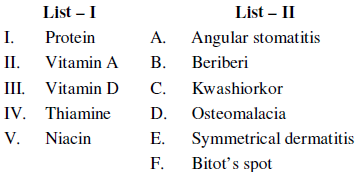
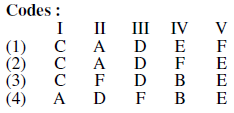
62. Match the active ingredient in List – I with the food sources in List – II.
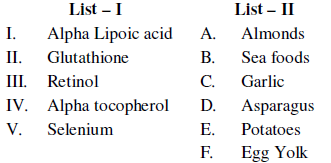
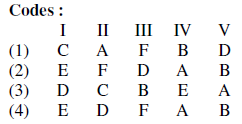
63. Match the category / age in List – I with their RDA for calcium in List – II.

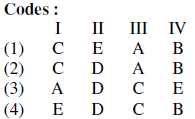
64. Match the terms in List – I with their explanation in List – II.


65. Match the items in List – I with their description in List – II.

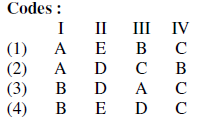
66. Match the finishes given in List – I with their purpose given in List – II.
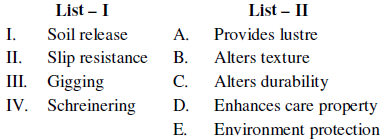
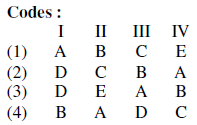
67. Match the items given in List – I with their description given in List – II.


68. Match the seams given in List – I with their descriptions given in List – II.

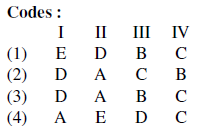
69. Match the items given in List-I with items given in List-II.
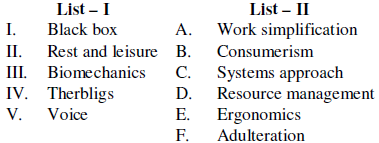
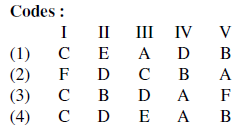
70. Match the items given in List-I with items given in List-II.

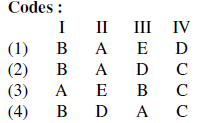
71. Match the theorists from List – I with the concepts from their theories in List – II.

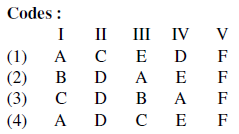
72. Match the milestones in List – I with their age of achievement in List – II.
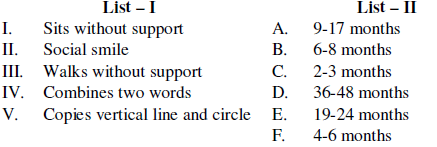
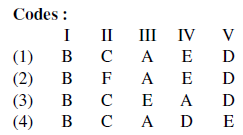
73. Match the items in List – I with List – II.

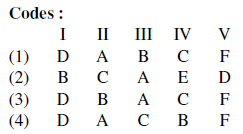
74. Match the Adopter category given by Evrett Rogers in List – I with their main characteristic feature given under List – II.
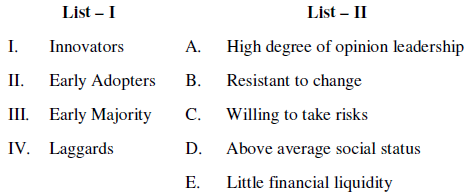 3
3

75. Match the name of the Programme given under List – I with the main issue it deals with given under List – II.
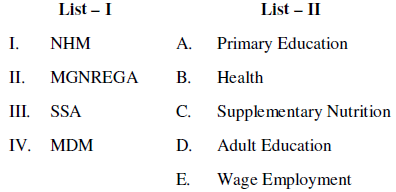
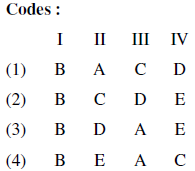
Latest Govt Job & Exam Updates: